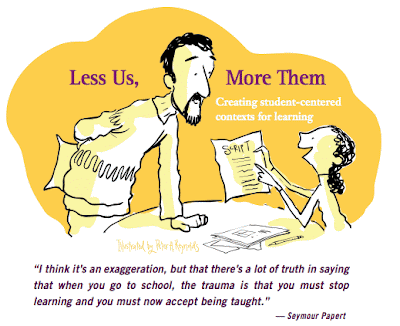We've all had the conversation before...
Should we focus on teaching facts, or should we focus on teaching kids how to think?
We can all agree that simple facts and information have become increasingly easy to obtain. The world has had a fundamental shift that has resulted in the value of facts and simple information going down drastically.
Now, I think there needs to be a clear distinction that recognizes that facts and information haven't lost their value in the sense that they are no longer necessary or important. We still need facts and simple information to do things. But, they have lost value in the sense that memorizing a ton of facts is no longer necessary.
So, the question is... do we focus on teaching facts or do we focus on teaching kids how to think?
From where I sit, I believe there needs to be a balance.
I don't think we can completely ignore simple facts and simple pieces of information. Now, don't get me wrong, I feel very strongly that classes that focus just on memorizing facts and simple pieces of information are doing a huge injustice for students. But, in the same breath, I think we need some simple facts and pieces of information before we can properly and effectively create, design, innovate, explore, and discover.
When we talk about kids learning how to think, we are reaching far beyond just knowing simple facts. Kids are going to learn to think as part of the process when they create, design, innovate, explore, and discover. However, for these higher levels of thinking to be the best they can be, kids will need to have some basic foundational pieces of information.
I may be wrong with these thoughts, but I don't think we can go all-in 100% one way or the other... there needs to be a balanced mix.
Should we focus on teaching facts, or should we focus on teaching kids how to think?
We can all agree that simple facts and information have become increasingly easy to obtain. The world has had a fundamental shift that has resulted in the value of facts and simple information going down drastically.
Now, I think there needs to be a clear distinction that recognizes that facts and information haven't lost their value in the sense that they are no longer necessary or important. We still need facts and simple information to do things. But, they have lost value in the sense that memorizing a ton of facts is no longer necessary.
So, the question is... do we focus on teaching facts or do we focus on teaching kids how to think?
From where I sit, I believe there needs to be a balance.
When we talk about kids learning how to think, we are reaching far beyond just knowing simple facts. Kids are going to learn to think as part of the process when they create, design, innovate, explore, and discover. However, for these higher levels of thinking to be the best they can be, kids will need to have some basic foundational pieces of information.
I may be wrong with these thoughts, but I don't think we can go all-in 100% one way or the other... there needs to be a balanced mix.

